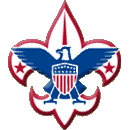Troop 315 strives to be a boy-led troop. This means that, under the guidance of the Scoutmaster, the boys themselves plan and execute the meetings and outings. To
implement this, we employ the patrol method of Scouting. A unique character of Troop 315 is that all of our Scouts tend to get along really well with each other and our older Scouts are very
supportive of our younger Scouts. We feel this is because, unlike many troops, we do not have a new-Scout patrol. We find that there is little chance of ridicule when new Scouts are mixed in
with the established Scout patrols. We try to place a new Scout into a patrol with at least one other boy he knows. Each patrol has a patrol leader (PL) and an assistant patrol leader (APL).
The boys in each patrol vote for their APL, who must be at least Second Class, working on First Class. The APL rotates into the position of PL after 6 months. The former PL rotates into the
position of instructor. The instructor and PL help teach skills to the new Scouts in their patrol. The PL, APL, and instructor model and teach leadership skills to the younger Scouts. A
certain amount of healthy competition is encouraged between patrols, which increases the Scoutís identification with his patrol while at the same time solidifies his knowledge of
Scout skills. Patrols are encouraged to go on patrol outings. These outings need not be supervised by adults and can include activities such as bowling, miniature golf, etc.
Scouts who have held the position of instructor and are of First Class rank are eligible to be voted into the position of Assistant Senior Patrol Leader (ASPL). Similar to
the APL, the ASPL rotates into the position of Senior Patrol Leader. First Class Scouts are eligible for assignment to other positions of leadership in the troop. These leadership positions
are quartermaster, scribe, historian, librarian, chaplainís aid, and guide. The SPL, working with the Scoutmaster, makes these assignments. The SPL is responsible for training the PLís,
while the ASPL(s) have the responsibility of training the Scouts in the other leadership positions. We try to have adult mentors work with Scouts in leadership positions. All leadership
positions last six months.
The SPL, ASPL(s), and the PL's make up the Patrol Leader Council (PLC). At the end of each month, the PLC meets to plan the meetings for the coming month and to review the
plans for the activities for that month. The troop scribe takes notes at these meetings.
The troop encourages leadership training for both Scouts and Scouters (adult leaders; see below). Boy Scouts who are in a position of leadership are expected to
participate in a one-day Junior Leadership Training program offered through the troop.

